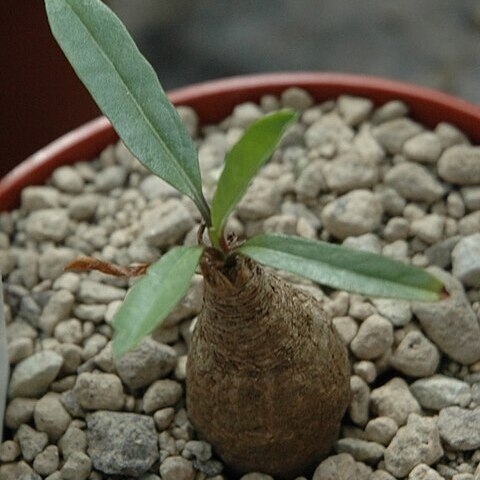Perennial; stems numerous from a fusiform tuberous rootstock, slender, 9–30 cm. long, prostrate or ascending, densely white-pilose above, glabrescent beneath.. Leaves very variable; radical ones largest; blades up to 8 cm. long and 1–4 cm. wide, 2–5(–9)-lobed or rarely entire or undulate, with lanceolate or oblong sparsely pilose lobes, the apical lobe the largest; upper cauline leaves smaller, subpalmately or pinnately 3–5-lobed, with linear to lanceolate lobes, the middle lobes usually longest and often lobed or toothed.. Flowers axillary, solitary, subsessile, or pedicel up to 12 mm. long.. Calyx densely long-pilose, 1.2 cm. long, very similar to that of the last 2 species.. Corolla mauve and white, tubular below; limb ± salver-shaped, l.4–3.2(–4) cm. long.. Capsule globose, 6 mm. in diameter.. Seeds as in species 4, I. polymorpha.
Perennial herb; producing a rosette of leaves. Stems procumbent or ascending. Leaves with blade linear (radical leaves) to subpalmately or pinnately 3-7-lobed (cauline leaves) with linear to narrowly ovate lobes, middle ones longest and often lobed or dentate at first, 40100 mm long, with soft, silvery white hairs, main veins prominent below. Flowers: solitary, axillary, subsessile or pedicel 5-15 mm long; calyx lobes ovate or narrowly ovate, aristate, ciliate with median keel of hairs; corolla up to 50 mm long, mauve to purple; Nov.-Mar. Fruit a globose, glabrous capsule, 8-10 mm in diameter; seeds densely pubescent.
Leaves very variable, the basal ones rosulate, (if present) long petiolate with a petiole up to 5 cm. long); leaf lamina lanceolate or linear, up to 8 × 1 cm., entire or with 1–2 lateral teeth or lobes or repando-pinnatisect 2–7–lobed, pilose, the apical lobe usually longer; cauline leaves 2–6·5 cm. long, usually subpalmately or pinnately 3–7–lobed, with linear to lanceolate lobes, the middle ones usually longest and often lobed or dentate at first with soft silvery-white hairs, soon glabrescent, main nerves prominent beneath.
A small spreading herb. It grows 15 cm high. It has a small carrot like tuber. This is 8 cm long by 2 cm wide. There are several stems from the top of the tuber. These are weak and thin and usually lie along the ground. The young early leaves point upwards and have a few lobes along the side. They can be 6 cm long by 1 cm wide. Older leaves are smaller and have deep lobes. The flowers are purple or pink. They open in the morning. The fruit are small, round capsules. The seeds are light brown and only a few occur.
Prostrate or ascending perennial herb. Leaves subpal-mately or pinnately 3-7-lobed with linear to lanceolate Lobes, middle ones longest and often lobed or dentate at first, with soft silvery white hairs, glabrescent. Sepals ovate or ovate-lanceolate, aristate, ciliate with median keel of hairs. Corolla up to 50 mm long. Flowers mauve to purple.
Erect perennial shrub, 0.3-1.0 m high, covered with short silvery adpressed pubescence. Leaves entire, linear to oblanceolate or lanceolate, base decurrent into short petiole, apex acute or obtuse, mucronate. Sepals lanceolate, acute or subacute. Corolla 35-70 mm long, funnel shaped. Flowers bright magenta or magenta-pink.
Sepals unequal ovate or ovate-lanceolate, aristate, ciliate with median keel of hairs, outer ones herbaceous, up to 13 mm. long, inner ones paler, more membranous and shorter, all becoming broader and brown in fruit.
Flowers axillary, solitary, subsessile or with a pedicel up to 15 mm. long; bracteoles linear-subulate or linear-filiform, 10–15 × 0·5 mm., pubescent.
Stems numerous, slender, up to 50 cm. long, prostrate or ascending, densely white-pilose above, glabrescent beneath.
Corolla narrowly funnel-shaped with spreading limb, mauve to purple, 2·3–5 cm. long, midpetaline areas glabrous.
Perennial, with a fusiform tuberous rootstock.
Capsule globose, glabrous, straw-coloured.
Seeds densely appressed pubescent.

